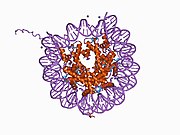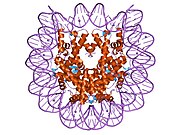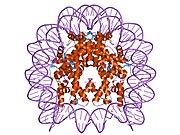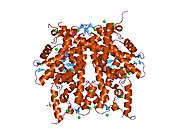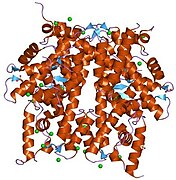HIST3H3
| H3-4 | |||||||||||||||||||||||||||||||||||||||||||||||||||
|---|---|---|---|---|---|---|---|---|---|---|---|---|---|---|---|---|---|---|---|---|---|---|---|---|---|---|---|---|---|---|---|---|---|---|---|---|---|---|---|---|---|---|---|---|---|---|---|---|---|---|---|
 | |||||||||||||||||||||||||||||||||||||||||||||||||||
| |||||||||||||||||||||||||||||||||||||||||||||||||||
| Identifiers | |||||||||||||||||||||||||||||||||||||||||||||||||||
| Aliases | H3-4, H3.4, H3/g, H3FT, H3t, histone cluster 3, H3, histone cluster 3 H3, HIST3H3, H3.4 histone | ||||||||||||||||||||||||||||||||||||||||||||||||||
| External IDs | OMIM: 602820; HomoloGene: 133212; GeneCards: H3-4; OMA:H3-4 - orthologs | ||||||||||||||||||||||||||||||||||||||||||||||||||
| |||||||||||||||||||||||||||||||||||||||||||||||||||
| |||||||||||||||||||||||||||||||||||||||||||||||||||
| |||||||||||||||||||||||||||||||||||||||||||||||||||
| |||||||||||||||||||||||||||||||||||||||||||||||||||
| Wikidata | |||||||||||||||||||||||||||||||||||||||||||||||||||
| |||||||||||||||||||||||||||||||||||||||||||||||||||
Histone H3.1t is a protein that in humans is encoded by the HIST3H3 gene.[3][4]
Histones are basic nuclear proteins that are responsible for the nucleosome structure of the chromosomal fiber in eukaryotes. Nucleosomes consist of approximately 146 bp of DNA wrapped around a histone octamer composed of pairs of each of the four core histones (H2A, H2B, H3, and H4). The chromatin fiber is further compacted through the interaction of a linker histone, H1, with the DNA between the nucleosomes to form higher order chromatin structures. This gene is intronless and encodes a member of the histone H3 family. Transcripts from this gene lack polyA tails; instead, they contain a palindromic termination element. This gene is located separately from the other H3 genes that are in the histone gene cluster on chromosome 6p22-p21.3.[5]
References
[edit]- ^ a b c ENSG00000285435 GRCh38: Ensembl release 89: ENSG00000168148, ENSG00000285435 – Ensembl, May 2017
- ^ "Human PubMed Reference:". National Center for Biotechnology Information, U.S. National Library of Medicine.
- ^ Albig W, Ebentheuer J, Klobeck G, Kunz J, Doenecke D (Dec 1996). "A solitary human H3 histone gene on chromosome 1". Hum Genet. 97 (4): 486–91. doi:10.1007/BF02267072. PMID 8834248. S2CID 27799958.
- ^ Marzluff WF, Gongidi P, Woods KR, Jin J, Maltais LJ (Oct 2002). "The human and mouse replication-dependent histone genes". Genomics. 80 (5): 487–98. doi:10.1016/S0888-7543(02)96850-3. PMID 12408966.
- ^ "Entrez Gene: HIST3H3 histone cluster 3, H3".
Further reading
[edit]- Govin J, Caron C, Rousseaux S, Khochbin S (2005). "Testis-specific histone H3 expression in somatic cells". Trends Biochem. Sci. 30 (7): 357–9. doi:10.1016/j.tibs.2005.05.001. PMID 15922600.
- Bernués J, Espel E, Querol E (1986). "Identification of the core-histone-binding domains of HMG1 and HMG2". Biochim. Biophys. Acta. 866 (4): 242–51. doi:10.1016/0167-4781(86)90049-7. PMID 3697355.
- Ishimi Y, Ichinose S, Omori A, et al. (1996). "Binding of human minichromosome maintenance proteins with histone H3". J. Biol. Chem. 271 (39): 24115–22. doi:10.1074/jbc.271.39.24115. PMID 8798650.
- Mizzen CA, Yang XJ, Kokubo T, et al. (1997). "The TAF(II)250 subunit of TFIID has histone acetyltransferase activity". Cell. 87 (7): 1261–70. doi:10.1016/S0092-8674(00)81821-8. PMID 8980232. S2CID 18409257.
- Witt O, Albig W, Doenecke D (1997). "Testis-specific expression of a novel human H3 histone gene". Exp. Cell Res. 229 (2): 301–6. doi:10.1006/excr.1996.0375. PMID 8986613.
- Rodriguez P, Munroe D, Prawitt D, et al. (1997). "Functional characterization of human nucleosome assembly protein-2 (NAP1L4) suggests a role as a histone chaperone". Genomics. 44 (3): 253–65. doi:10.1006/geno.1997.4868. PMID 9325046.
- Albig W, Doenecke D (1998). "The human histone gene cluster at the D6S105 locus". Hum. Genet. 101 (3): 284–94. doi:10.1007/s004390050630. PMID 9439656. S2CID 38539096.
- El Kharroubi A, Piras G, Zensen R, Martin MA (1998). "Transcriptional activation of the integrated chromatin-associated human immunodeficiency virus type 1 promoter". Mol. Cell. Biol. 18 (5): 2535–44. doi:10.1128/mcb.18.5.2535. PMC 110633. PMID 9566873.
- Zhang Y, Sun ZW, Iratni R, et al. (1998). "SAP30, a novel protein conserved between human and yeast, is a component of a histone deacetylase complex". Mol. Cell. 1 (7): 1021–31. doi:10.1016/S1097-2765(00)80102-1. PMID 9651585.
- Lorain S, Quivy JP, Monier-Gavelle F, et al. (1998). "Core histones and HIRIP3, a novel histone-binding protein, directly interact with WD repeat protein HIRA". Mol. Cell. Biol. 18 (9): 5546–56. doi:10.1128/MCB.18.9.5546. PMC 109139. PMID 9710638.
- Becker W, Weber Y, Wetzel K, et al. (1998). "Sequence characteristics, subcellular localization, and substrate specificity of DYRK-related kinases, a novel family of dual specificity protein kinases". J. Biol. Chem. 273 (40): 25893–902. doi:10.1074/jbc.273.40.25893. PMID 9748265.
- Carrier F, Georgel PT, Pourquier P, et al. (1999). "Gadd45, a p53-responsive stress protein, modifies DNA accessibility on damaged chromatin". Mol. Cell. Biol. 19 (3): 1673–85. doi:10.1128/MCB.19.3.1673. PMC 83961. PMID 10022855.
- Sassone-Corsi P, Mizzen CA, Cheung P, et al. (1999). "Requirement of Rsk-2 for epidermal growth factor-activated phosphorylation of histone H3". Science. 285 (5429): 886–91. doi:10.1126/science.285.5429.886. PMID 10436156.
- Thomson S, Clayton AL, Hazzalin CA, et al. (1999). "The nucleosomal response associated with immediate-early gene induction is mediated via alternative MAP kinase cascades: MSK1 as a potential histone H3/HMG-14 kinase". EMBO J. 18 (17): 4779–93. doi:10.1093/emboj/18.17.4779. PMC 1171550. PMID 10469656.
- Hsieh YJ, Kundu TK, Wang Z, et al. (1999). "The TFIIIC90 subunit of TFIIIC interacts with multiple components of the RNA polymerase III machinery and contains a histone-specific acetyltransferase activity". Mol. Cell. Biol. 19 (11): 7697–704. doi:10.1128/mcb.19.11.7697. PMC 84812. PMID 10523658.
- Cheung P, Tanner KG, Cheung WL, et al. (2000). "Synergistic coupling of histone H3 phosphorylation and acetylation in response to epidermal growth factor stimulation". Mol. Cell. 5 (6): 905–15. doi:10.1016/S1097-2765(00)80256-7. PMID 10911985.
- Buggy JJ, Sideris ML, Mak P, et al. (2001). "Cloning and characterization of a novel human histone deacetylase, HDAC8". Biochem. J. 350 (1): 199–205. doi:10.1042/0264-6021:3500199. PMC 1221242. PMID 10926844.
- Deng L, de la Fuente C, Fu P, et al. (2001). "Acetylation of HIV-1 Tat by CBP/P300 increases transcription of integrated HIV-1 genome and enhances binding to core histones". Virology. 277 (2): 278–95. doi:10.1006/viro.2000.0593. PMID 11080476.
- Seo SB, McNamara P, Heo S, et al. (2001). "Regulation of histone acetylation and transcription by INHAT, a human cellular complex containing the set oncoprotein". Cell. 104 (1): 119–30. doi:10.1016/S0092-8674(01)00196-9. PMID 11163245. S2CID 11144887.




